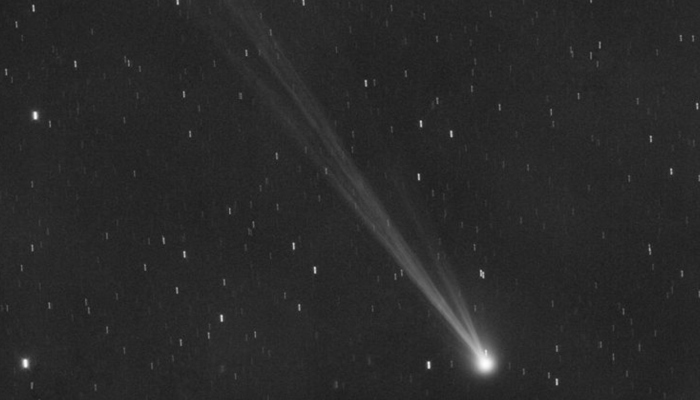Comet Nishimura to light up night sky this weekend — Here's how you can watch it
Since its discovery, the comet has steadily grown brighter as it journeys through the inner solar system in its orbit around the sun
A newly discovered comet is set to grace the night sky in the coming week, offering a celestial spectacle for those with the expertise to spot it.
Japanese space photographer Hideo Nishimura initially detected Comet Nishimura in early August while capturing images of the night sky, as reported by EarthSky.
Since its discovery, the comet has steadily grown brighter as it journeys through the inner solar system in its orbit around the sun.
On Tuesday, the comet will make its closest approach to Earth, coming within a distance of 78 million miles (125 million kilometres), offering a potential viewing opportunity over the next five days.
It will then venture much closer to the sun, passing within 21 million miles (almost 34 million kilometres) of the star on September 17, according to Alan Hale, co-discoverer of Comet Hale-Bopp and founder and president of the Earthrise Institute.
Comet Nishimura's orbit is quite lengthy, completing one revolution every 430 to 440 years. This implies that the last time it came close to the Sun (and possibly to Earth) was around the year 1590, predating the invention of telescopes.
Dr Paul Chodas, director of NASA's Center for Near Earth Object Studies at the Jet Propulsion Laboratory in Pasadena, California, noted, "We don't know whether it got bright enough to be seen with the naked eye back then."
While there are no recorded comets from that period that correspond to Nishimura, it would have needed to be exceptionally bright to be visible, Hale commented.
To catch a glimpse of Comet Nishimura, observers will require binoculars due to its faint appearance resulting from its distance and its proximity to the horizon. Optimal viewing conditions can be found in dark skies far from the glow of city lights.
Sky and Telescope has provided charts to assist stargazers in locating the comet.
When distinguishing the comet from other celestial objects, remember that the comet's tail always points away from the sun, as sunlight continuously exerts pressure on the fine dust particles, explained Dave Schleicher, an astronomer at Lowell Observatory in Arizona.
Although the comet appears greenish in photographs due to the presence of diatomic carbon when viewed through binoculars, it will appear nearly colourless or slightly pink as sunlight reflects off dust grains smaller than those in talcum powder, Schleicher noted.
For those in the Northern Hemisphere, Chodas recommends seeking a clear view of the east-northeast horizon approximately half an hour before morning twilight. You can utilize Time and Date to determine when morning twilight, also referred to as civil twilight, commences in your location.
"Each day this week, the comet is getting a little closer to the Sun, the time window gets narrower, and the comet gets even closer to the horizon," he added. "This will not be an easy comet to see, unless you've observed comets before."
As the comet nears the sun and the horizon, visibility becomes increasingly challenging.
On Wednesday, the comet will pass between Earth and the sun. However, it is expected to be inaccessible in the evening sky for a few days afterwards, as it will still be in close proximity to the sun and obscured by bright twilight, Hale cautioned.
Regarding the fate of Comet Nishimura, its proximity to the sun might subject it to intense heat, which could potentially lead to its disintegration.
"As the frozen ices heat up and sublimate into gases, the comet may break up," Chodas explained. "It depends a lot on the size of the nucleus, which we don't know since it's surrounded by the 'coma,' an atmosphere of gas and dust."
Nonetheless, considering that the comet has survived at least one previous close encounter with the sun, and likely many more (though its age remains unknown), Hale and other experts anticipate its survival.
"If it survives its passage by the sun, it will pass over to the far side of the sun from Earth in early October, and then emerge into the Southern Hemisphere's morning sky in November," Hale mentioned. "It may remain visible for several months thereafter, although it will likely be a rather dim object, which will keep fading as it recedes from the sun and Earth."
Following this event, more than 400 years will elapse before the comet makes another close approach to Earth.
In the event you miss the opportunity to observe Comet Nishimura, Hale noted that there are several other comets expected to grace the night sky over the next 16 months.
Comet Pons-Brooks is set to be closest to the sun in April and should be faintly visible to the naked eye in the evening sky for about a month before then.
In June, Comet Olbers will closely approach the sun and can be spotted with binoculars.
Comet Tsuchinshan-ATLAS, discovered in January, will reach its closest point to the sun in late September 2024 and will pass by Earth in mid-October 2024, with the potential to become very bright.
-
Queens mother arrested after abducting child from court-ordered visit
-
Kentucky grandmother arrested after toddlers with broken skulls, ribs
-
Cheaper cars, fewer EVs: Trump administration shifts ‘auto policy’ focus
-
European leaders slam Trump’s tariff threat over Greenland as ‘unacceptable’
-
Nova Scotia snow storm warning issued as heavy snow moves in
-
Trump warns of new tariffs for countries opposed to Greenland takeover
-
Global cooperation on deathwatch: UN chief warns of ‘powerful forces’ in play
-
Insurrection Act in Minneapolis? Trump says 'not right now'












